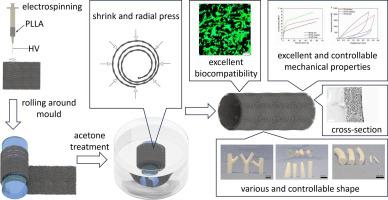当前位置:
X-MOL 学术
›
Mater. Des.
›
论文详情
Our official English website, www.x-mol.net, welcomes your feedback! (Note: you will need to create a separate account there.)
Hierarchical porous poly (L-lactic acid) fibrous vascular graft with controllable architectures and stable structure
Materials & Design ( IF 8.4 ) Pub Date : 2024-03-11 , DOI: 10.1016/j.matdes.2024.112829 Chen Meng , Jun Song , Samira Malekmohammadi , Jinmin Meng , Wenyuan Wei , Renzhi Li , Jiling Feng , R. Hugh Gong , Jiashen Li
Materials & Design ( IF 8.4 ) Pub Date : 2024-03-11 , DOI: 10.1016/j.matdes.2024.112829 Chen Meng , Jun Song , Samira Malekmohammadi , Jinmin Meng , Wenyuan Wei , Renzhi Li , Jiling Feng , R. Hugh Gong , Jiashen Li

|
Electrospun fibre has shown great potential in tissue engineering and regenerative medicine due to its high specific surface area and extracellular matrix-mimicking structure. However, fabricating an electrospun fibrous scaffold with controllable complex 3D macroscopic configuration remains a challenge. In the present study, a novel method was designed to transform 2D electrospun poly (L-lactic acid) (PLLA) fibrous membrane to tubular PLLA fibrous scaffolds with 3D complex but tailored configuration. The electrospun PLLA fibrous membrane was rolled around a designed mould and then treated with acetone. Treated vascular grafts’ length, diameter, and shape can be tailored by the mould parameters. Moreover, treated vascular grafts achieve favourable mechanical properties (Young’s modulus = 155 MPa, tensile stress = 8.79 MPa and radial force = 2.2 N) and the mechanical properties could be engineered on demand. In addition, treated vascular grafts kept their initial structure and size during long-term experiments once they were formed. In addition, with the acetone-induced recrystallization of PLLA, pristine solid PLLA fibres were changed to hierarchical porous PLLA fibres with ultra-high specific surface area (28.9 m/g) and wettability (water contact angle = 101.32°), which has positive effects on cell adhesion and proliferation ability. A7r5 experiment shows that the proliferation rate of treated vascular grafts increased 153% at day 4 and 170.6% at day 7 compared with pristine vascular grafts.
中文翻译:

结构可控、结构稳定的分层多孔聚(L-乳酸)纤维血管移植物
静电纺纤维由于其高比表面积和模拟细胞外基质的结构,在组织工程和再生医学方面显示出巨大的潜力。然而,制造具有可控复杂 3D 宏观结构的电纺纤维支架仍然是一个挑战。在本研究中,设计了一种新方法,将 2D 电纺聚(L-乳酸)(PLLA)纤维膜转化为具有 3D 复杂但定制配置的管状 PLLA 纤维支架。将电纺 PLLA 纤维膜绕在设计的模具上滚动,然后用丙酮处理。处理后的血管移植物的长度、直径和形状可以通过模具参数来定制。此外,经过处理的血管移植物具有良好的机械性能(杨氏模量= 155 MPa,拉伸应力= 8.79 MPa,径向力= 2.2 N),并且可以根据需要设计机械性能。此外,经过处理的血管移植物一旦形成,在长期实验中仍保持其初始结构和尺寸。此外,通过丙酮诱导PLLA重结晶,原始固体PLLA纤维转变为具有超高比表面积(28.9 m/g)和润湿性(水接触角=101.32°)的分级多孔PLLA纤维,具有积极的应用前景。对细胞粘附和增殖能力的影响。 A7r5实验表明,与原始血管移植物相比,处理后的血管移植物的增殖率在第4天增加了153%,在第7天增加了170.6%。
更新日期:2024-03-11
中文翻译:

结构可控、结构稳定的分层多孔聚(L-乳酸)纤维血管移植物
静电纺纤维由于其高比表面积和模拟细胞外基质的结构,在组织工程和再生医学方面显示出巨大的潜力。然而,制造具有可控复杂 3D 宏观结构的电纺纤维支架仍然是一个挑战。在本研究中,设计了一种新方法,将 2D 电纺聚(L-乳酸)(PLLA)纤维膜转化为具有 3D 复杂但定制配置的管状 PLLA 纤维支架。将电纺 PLLA 纤维膜绕在设计的模具上滚动,然后用丙酮处理。处理后的血管移植物的长度、直径和形状可以通过模具参数来定制。此外,经过处理的血管移植物具有良好的机械性能(杨氏模量= 155 MPa,拉伸应力= 8.79 MPa,径向力= 2.2 N),并且可以根据需要设计机械性能。此外,经过处理的血管移植物一旦形成,在长期实验中仍保持其初始结构和尺寸。此外,通过丙酮诱导PLLA重结晶,原始固体PLLA纤维转变为具有超高比表面积(28.9 m/g)和润湿性(水接触角=101.32°)的分级多孔PLLA纤维,具有积极的应用前景。对细胞粘附和增殖能力的影响。 A7r5实验表明,与原始血管移植物相比,处理后的血管移植物的增殖率在第4天增加了153%,在第7天增加了170.6%。



























 京公网安备 11010802027423号
京公网安备 11010802027423号